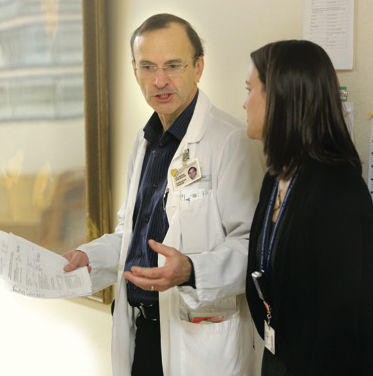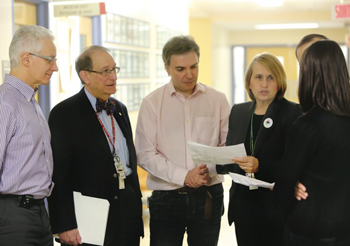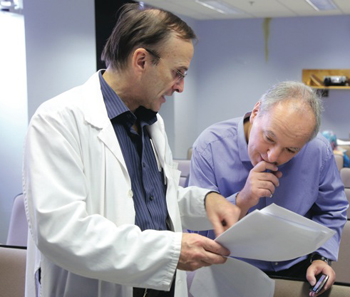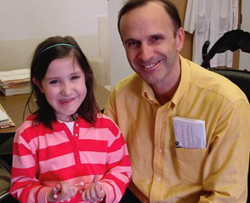Treating babies before they take their first breath

Dr. Jean-Martin Laberge (left) , Pediatric Surgeon and Andrea Secord, Genetic Counsellor.
The University of California in San Francisco (UCSF) was the first in the world to perform open fetal surgery in 1981. Repairing birth defects in the womb was no longer science fiction—the unborn child had become a patient.
This tectonic shift in medicine had a direct impact on The Montreal Children’s Hospital (MCH) and the future of fetal medicine in Canada. At the MCH, the Fetal Diagnosis and Treatment Group (FDTG) was born. It is now one of the few specialty centres in the world that provides prenatal diagnosis, care for mothers who carry babies with congenital abnormalities, and medical and surgical intervention for the fetus.
Recognized as a Canadian leader in the emergent field of fetal therapy, the FDTG is the brainchild of Dr. Jean-Martin Laberge, who conducted fetal surgery research at the UCSF in 1984. “I wanted a front row seat to learn from the pioneer in fetal surgery,” he says. “The awe of intervening before birth, to save the unborn child, or to prevent or minimize severe consequences of malformations, attracted me to this nascent field.”

(Left to right) Dr. Samir Khalife, Dr. David Rosenblatt, Dr. Richard Brown, Lola Cartier, Genetic Counsellor, Dr. Jean-Martin Laberge (not seen) and Andrea Secord (not seen) take part in biweekly rounds.
When he returned to Montreal, Dr. Laberge set up a multidisciplinary fetal team at the MCH, which attracted experts from other medical institutions. The Royal Victoria Hospital (RVH) was the first to partner with the MCH and the (Sir Mortimer B. Davis) Jewish General Hospital and St. Mary’s Hospital came aboard a few years later.
“We were probably the first centre to have an integrated ‘fetal interest’ team in Canada, but we did not make the FDTG official until 15 years later at a press conference in 2000,” explains Dr. Laberge. Fetal interventionists on the team include pediatric surgeons, neurosurgeons, pediatric cardiologists, perinatalogists, neonatologists and genetic counsellors.
But another event would soon thrust the FDTG into the limelight. In December 2000, Dr. Laberge and his surgical team made international headlines when they performed the first EXIT procedure (Ex-utero Intrapartum Treatment) in Quebec. They operated on a 32-week gestation fetus with a massive teratoma attached to her neck while she was still in her mother’s womb. The benign, but life-threatening growth was larger than the baby’s head and weighed 1.4 kg, almost as much as she did once the tumour was removed (1.6 kg).

Dr. Jean-Martin Laberge (left) and Dr. Robert Gagnon, Director of the McGill Division of Maternal-Fetal Medicine and Director of the MUHC Division of Obstetrics, discuss a case following the Fetal Diagnosis and Treatment Group’s biweekly rounds.
A total of 42 specialists participated in the risky birth and corrective surgery.
A modified caesarean section was performed while the mother was under deep maternal anesthesia to allow the uterus to relax and expose parts of the baby. The upper body and the teratoma were cautiously lifted from the womb and both were held for almost 40 minutes as Dr. Laberge and pediatric anesthesiologist Dr. Karen Brown inserted a breathing tube into the baby girl and checked its position by bronchoscopy. When her breathing was assured, the umbilical cord was clamped and little Liora was born.
Three hours after her birth, Dr. Laberge removed the teratoma in a complicated and delicate operation that lasted almost four hours. Liora was then admitted to the Neonatal Intensive Care Unit where she stayed for the next three months. She is now a vibrant and happy 12 - year old.

Liora (left), seen here with Dr. Jean-Martin Laberge, was the first baby born in Quebec by EXIT procedure (Ex-utero Intrapartum Treatment), which was performed when Liora’s mother was at 32 weeks gestation.
Today, the FDTG is recognized for its excellence and compassionate care. The highly accomplished multidisciplinary team of specialists and subspecialists provide different types of procedures, including prenatal intervention that can correct a number of birth defects, such as lung cysts, urinary blockages, certain types of tumours and cardiac defects. Open fetal surgery, during which the fetus is partially lifted out of the womb, is used to repair potentially devastating conditions such as spina bifida, a malformation of the spinal cord or its coverings; and fetoscopic surgery, which is one of the less invasive methods, is commonly used to treat twin-twin transfusion syndrome, a condition where a twin absorbs most of the blood supply at the expense of the other.
And the future of the FDTG continues to look bright. Dr. Laberge says services will be enhanced when the MCH and RVH move to the Glen site in 2015. “Working together under one roof will allow us to treat more babies before they take their first breath.”
